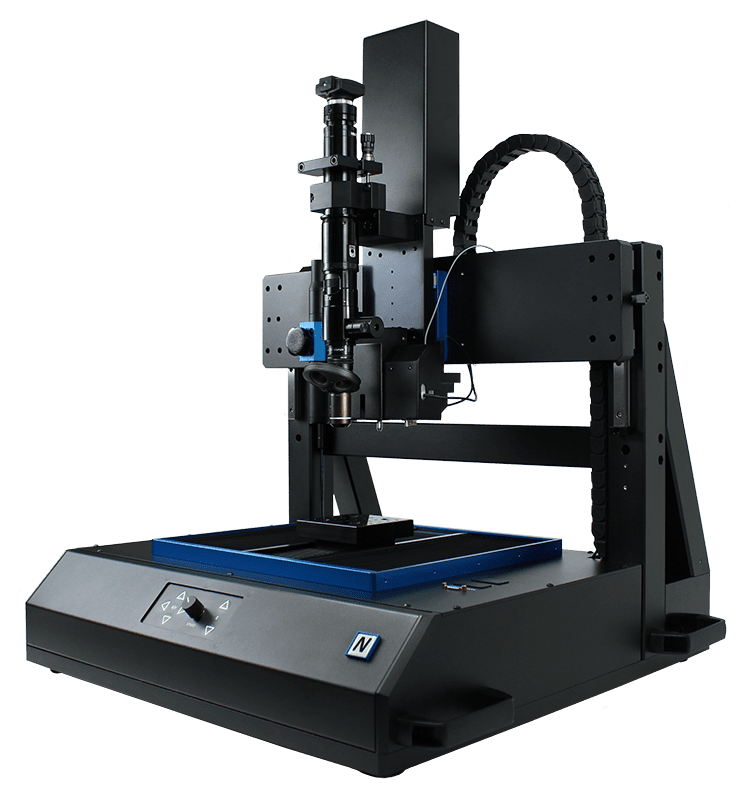
Dynamic Mechanical Analysis (DMA) Frequency Sweep on Polymer
DMA FREQUENCY SWEEP
ON POLYMER USING NANOINDENTATION

Prepared by
Duanjie Li, PhD
INTRODUCTION
IMPORTANCE OF DYNAMIC MECHANICAL ANALYSIS FREQUENCY SWEEP TEST
The changing frequency of the stress often leads to variations in the complex modulus, which is a critical mechanical property of polymers. For example, tires are subjected to cyclical high deformations when vehicles are running on the road. The frequency of the pressure and deformation changes as the car accelerates to higher speeds. Such a change can result in variation in the viscoelastic properties of the tire, which are important factors in the car performance. A reliable and repeatable test of the viscoelastic behavior of polymers at different frequencies is in need. The Nano module of the NANOVEA Mechanical Tester generates sinusoidal load by a high precision piezo actuator and directly measures the evolution of force and displacement using ultrasensitive load cell and capacitor. The combination of easy setup and high accuracy makes it an ideal tool for Dynamic Mechanical Analysis frequency sweep.
Viscoelastic materials exhibit both viscous and elastic characteristics when undergoing deformation. Long molecular chains in polymer materials contribute to their unique viscoelastic properties, i.e. a combination of the characteristics of both elastic solids and Newtonian fluids. Stress, temperature, frequency and other factors all play roles in the viscoelastic properties. Dynamic Mechanical Analysis, also known as DMA, studies the viscoelastic behavior and complex modulus of the material by applying a sinusoidal stress and measuring the change of strain.
MEASUREMENT OBJECTIVE
In this application, we study viscoelastic properties of a polished tire sample at different DMA frequencies using the Most Powerful Mechanical Tester, NANOVEA PB1000, in Nanoindentation mode.
NANOVEA
PB1000
TEST CONDITIONS
FREQUENCIES (Hz):
0.1, 1.5, 10, 20
CREEP TIME AT EACH FREQ.
50 sec
OSCILLATION VOLTAGE
0.1 V
LOADING VOLTAGE
1 V
indenter type
Spherical
Diamond | 100 μm
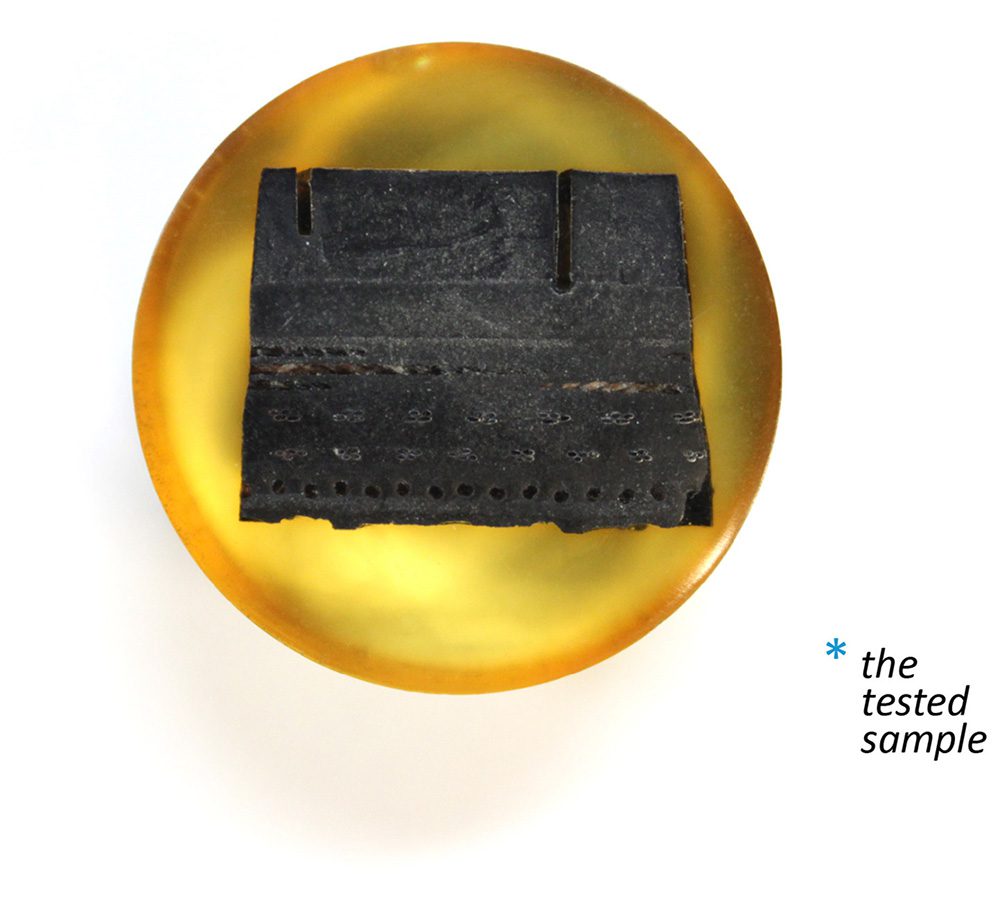
RESULTS & DISCUSSION
The Dynamic Mechanical Analysis frequency sweep at the maximum load allows a fast and simple measurement on the viscoelastic characteristics of the sample at different loading frequencies in one test. The phase shift and the amplitudes of the load and displacement waves at different frequencies can be used to calculate a variety of fundamental material viscoelastic properties, including Storage Modulus, Loss Modulus and Tan (δ) as summarized in the following graphs.
Frequencies of 1, 5, 10 and 20 Hz in this study, correspond to speeds of about 7, 33, 67 and 134 km per hour. As the test frequency increases from 0.1 to 20 Hz, it can be observed that both Storage Modulus and Loss Modulus progressively increase. Tan (δ) decreases from ~0.27 to 0.18 as the frequency increases from 0.1 to 1 Hz, and then it gradually increases to ~0.55 when the frequency of 20 Hz is reached. DMA frequency sweep allows measuring the trends of Storage Modulus, Loss Modulus and Tan (δ), which provide information on the movement of the monomers and cross-linking as well as the glass transition of polymers. By raising the temperature using a heating plate during the frequency sweep, a more complete picture of the nature of the molecular motion under different test conditions can be obtained.
EVOLUTION OF LOAD & DEPTH
OF THE FULL DMA FREQUENCY SWEEP
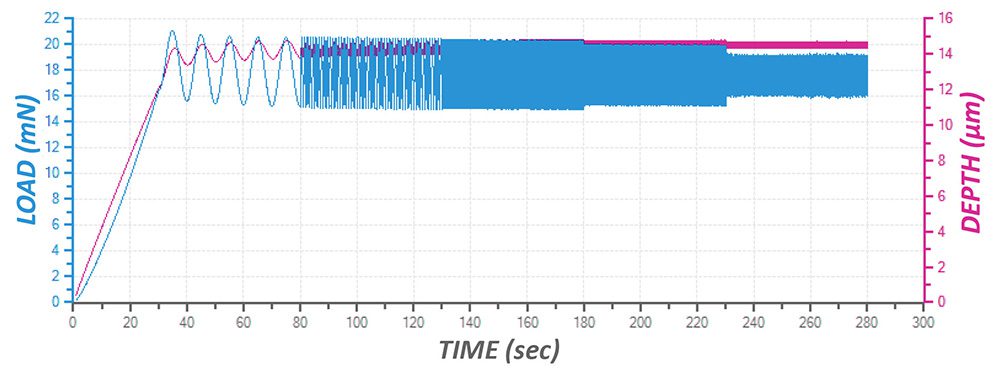
LOAD & DEPTH vs TIME AT DIFFERENT FREQUENCIES
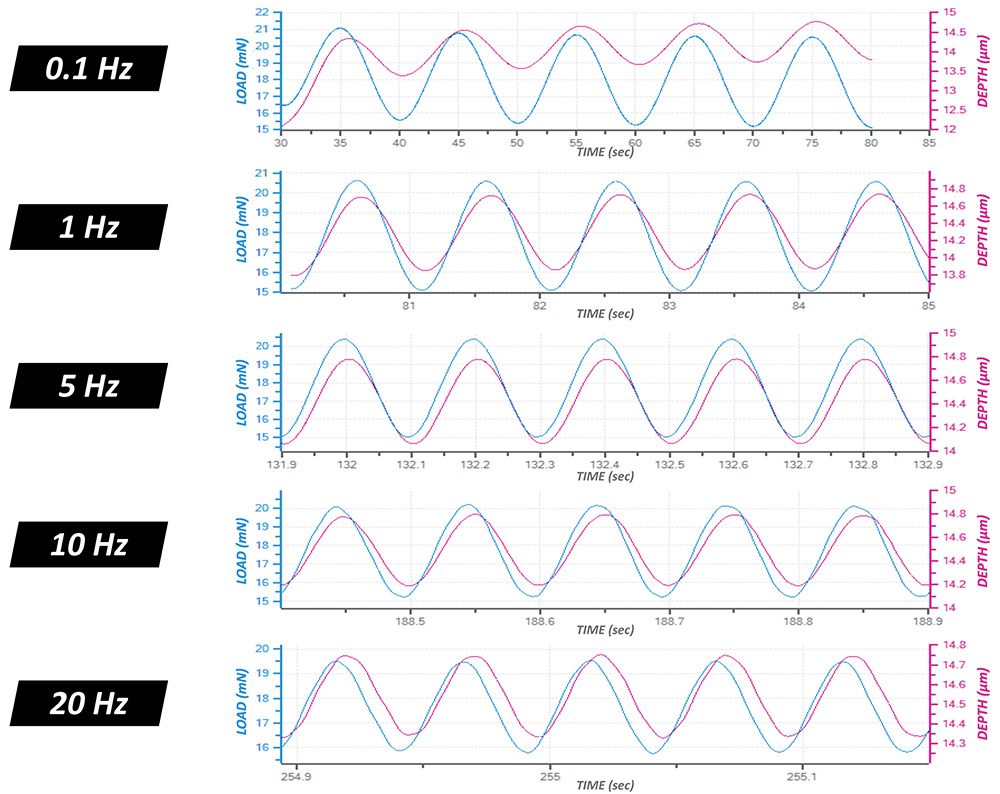
STORAGE MODULUS
AT DIFFERENT FREQUENCIES
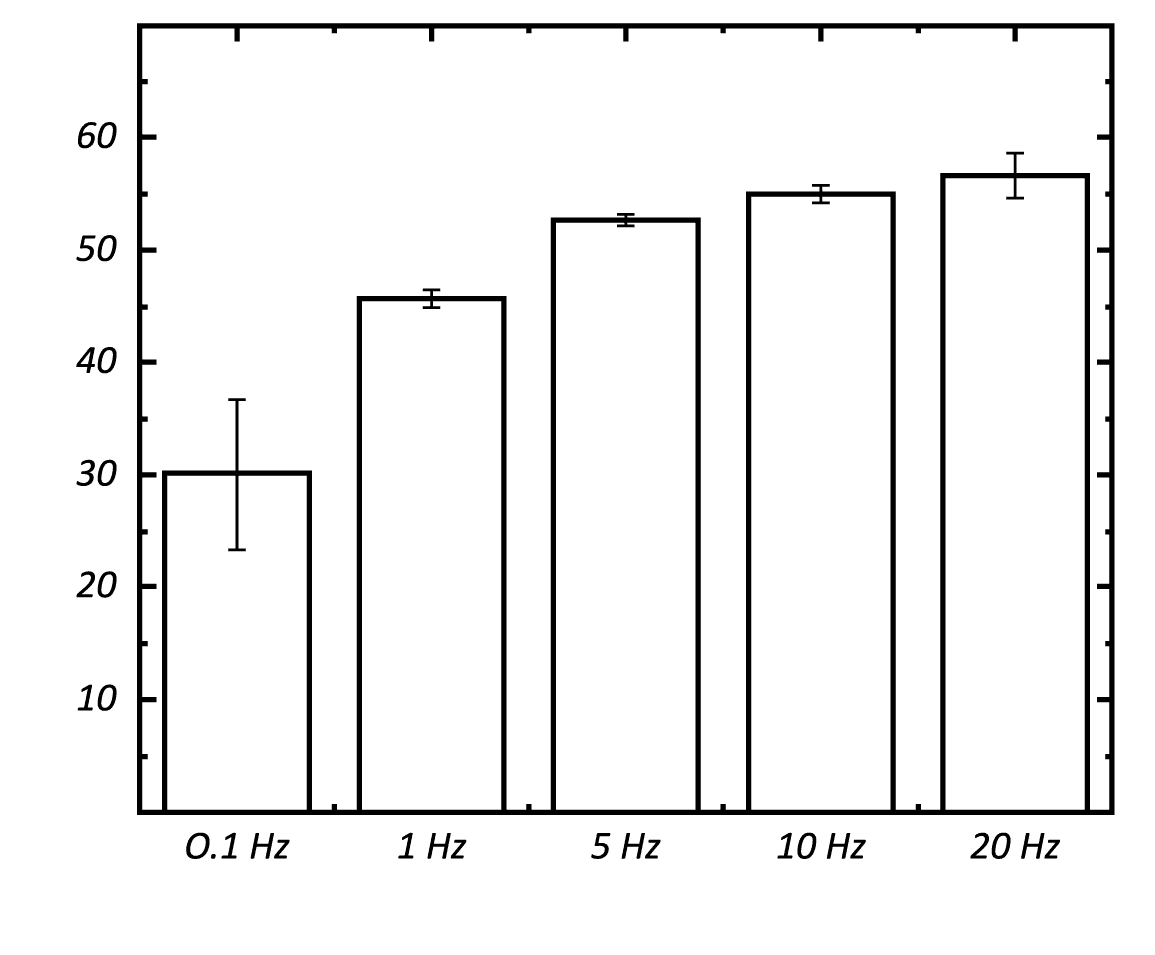
LOSS MODULUS
AT DIFFERENT FREQUENCIES
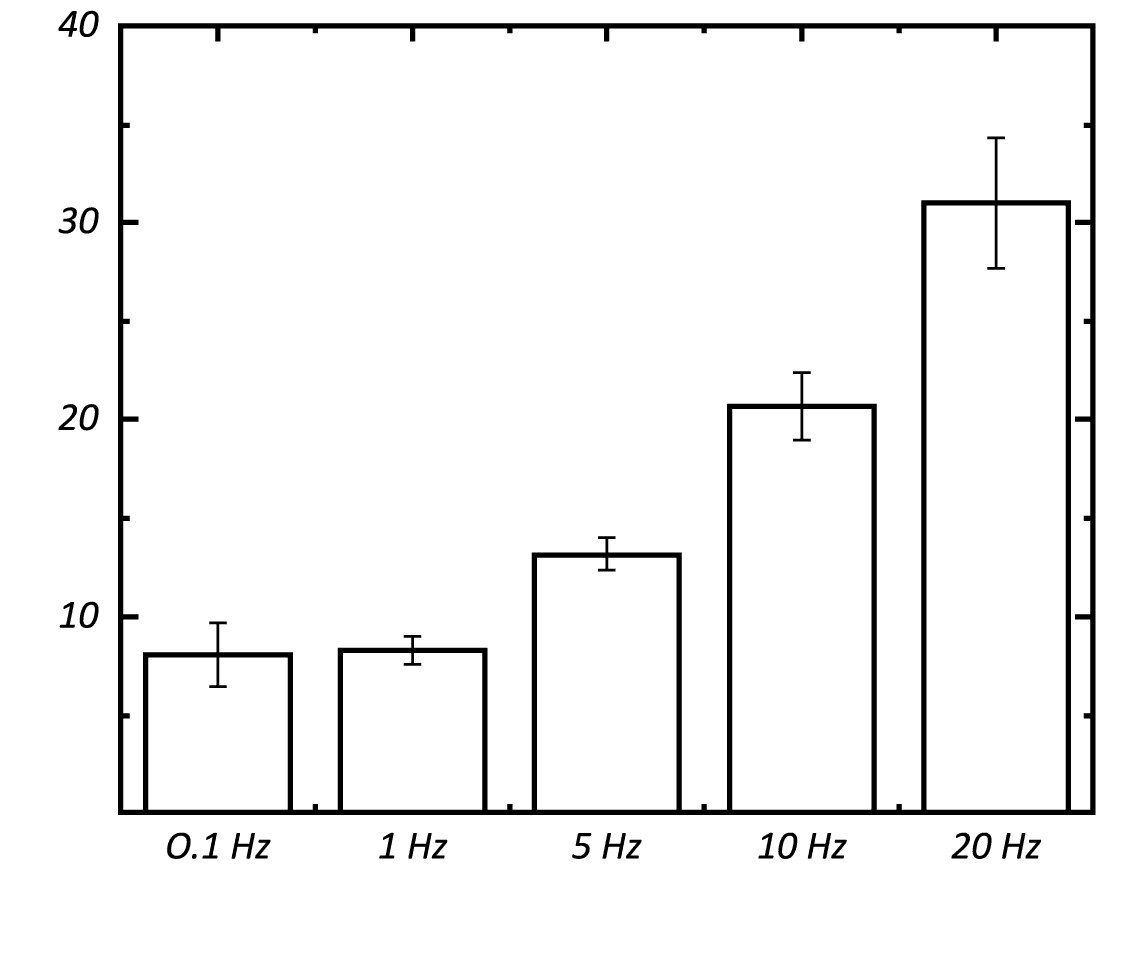
TAN (δ)
AT DIFFERENT FREQUENCIES
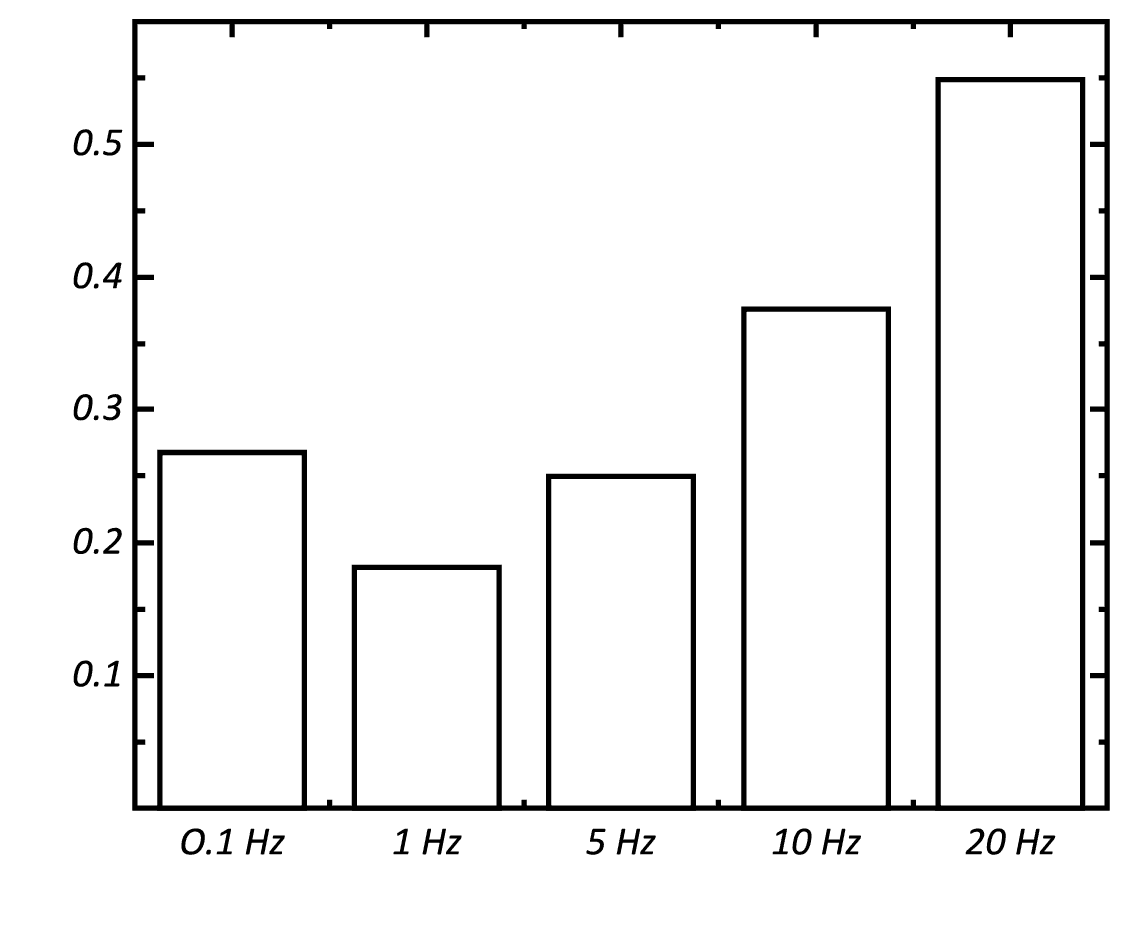
CONCLUSION
In this study, we showcased the capacity of the NANOVEA Mechanical Tester in performing the Dynamic Mechanical Analysis frequency sweep test on a tire sample. This test measures the viscoelastic properties of the tire at different frequencies of stress. The tire shows increased storage and loss modulus as the loading frequency increases from 0.1 to 20 Hz. It provides useful information on the viscoelastic behaviors of the tire running at different speeds, which is essential in improving the performance of tires for smoother and safer rides. The DMA frequency sweep test can be performed at various temperatures to mimic the realistic working environment of the tire under different weather.
In the Nano Module of the NANOVEA Mechanical Tester, the load application with the fast piezo is independent from the load measurement done by a separate high sensitivity strain gage. This gives a distinct advantage during Dynamic Mechanical Analysis since the phase between depth and load is measured directly from the data collected from the sensor. The calculation of phase is direct and does not need mathematical modeling that adds inaccuracy to the resulting loss and storage modulus. This is not the case for a coil-based system.
In conclusion, DMA measures loss and storage modulus, complex modulus and Tan (δ) as a function of contact depth, time and frequency. Optional heating stage allows determination of materials phase transition temperature during DMA. The NANOVEA Mechanical Testers provide unmatched multi-function Nano and Micro modules on a single platform. Both the Nano and Micro modules include scratch tester, hardness tester and wear tester modes, providing the widest and most user friendly range of testing available on a single module.
NOW, LET'S TALK ABOUT YOUR APPLICATION
Categorías
- Application Notes
- Block on Ring Tribology
- Corrosion Tribology
- Friction Testing | Coefficient of Friction
- High Temperature Mechanical Testing
- High Temperature Tribology
- Humidity and Gases Tribology
- Humidity Mechanical Testing
- Indentation | Creep and Relaxation
- Indentation | Fracture Toughness
- Indentation | Hardness and Elastic
- Indentation | Loss and Storage
- Indentation | Stress vs Strain
- Indentation | Yield Strength and Fatigue
- Laboratory Testing
- Linear Tribology
- Liquid Mechanical Testing
- Liquid Tribology
- Low Temperature Tribology
- Mechanical Testing
- Press Release
- Profilometry | Flatness and Warpage
- Profilometry | Geometry and Shape
- Profilometry | Roughness and Finish
- Profilometry | Step Height and Thickness
- Profilometry | Texture and Grain
- Profilometry | Volume and Area
- Profilometry Testing
- Ring on Ring Tribology
- Rotational Tribology
- Scratch Testing | Adhesive Failure
- Scratch Testing | Cohesive Failure
- Scratch Testing | Multi-Pass Wear
- Scratch Testing | Scratch Hardness
- Scratch Testing Tribology
- Tradeshow
- Tribology Testing
- Uncategorized
Archivos
- septiembre 2023
- agosto 2023
- junio 2023
- mayo 2023
- julio 2022
- mayo 2022
- abril 2022
- enero 2022
- diciembre 2021
- noviembre 2021
- octubre 2021
- septiembre 2021
- agosto 2021
- julio 2021
- junio 2021
- mayo 2021
- marzo 2021
- febrero 2021
- diciembre 2020
- noviembre 2020
- octubre 2020
- septiembre 2020
- julio 2020
- mayo 2020
- abril 2020
- marzo 2020
- febrero 2020
- enero 2020
- noviembre 2019
- octubre 2019
- septiembre 2019
- agosto 2019
- julio 2019
- junio 2019
- mayo 2019
- abril 2019
- marzo 2019
- enero 2019
- diciembre 2018
- noviembre 2018
- octubre 2018
- septiembre 2018
- julio 2018
- junio 2018
- mayo 2018
- abril 2018
- marzo 2018
- febrero 2018
- noviembre 2017
- octubre 2017
- septiembre 2017
- agosto 2017
- junio 2017
- mayo 2017
- abril 2017
- marzo 2017
- febrero 2017
- enero 2017
- noviembre 2016
- octubre 2016
- agosto 2016
- julio 2016
- junio 2016
- mayo 2016
- abril 2016
- marzo 2016
- febrero 2016
- enero 2016
- diciembre 2015
- noviembre 2015
- octubre 2015
- septiembre 2015
- agosto 2015
- julio 2015
- junio 2015
- mayo 2015
- abril 2015
- marzo 2015
- febrero 2015
- enero 2015
- noviembre 2014
- octubre 2014
- septiembre 2014
- agosto 2014
- julio 2014
- junio 2014
- mayo 2014
- abril 2014
- marzo 2014
- febrero 2014
- enero 2014
- diciembre 2013
- noviembre 2013
- octubre 2013
- septiembre 2013
- agosto 2013
- julio 2013
- junio 2013
- mayo 2013
- abril 2013
- marzo 2013
- febrero 2013
- enero 2013
- diciembre 2012
- noviembre 2012
- octubre 2012
- septiembre 2012
- agosto 2012
- julio 2012
- junio 2012
- mayo 2012
- abril 2012
- marzo 2012
- febrero 2012
- enero 2012
- diciembre 2011
- noviembre 2011
- octubre 2011
- septiembre 2011
- agosto 2011
- julio 2011
- junio 2011
- mayo 2011
- noviembre 2010
- enero 2010
- abril 2009
- marzo 2009
- enero 2009
- diciembre 2008
- octubre 2008
- agosto 2007
- julio 2006
- marzo 2006
- enero 2005
- abril 2004
